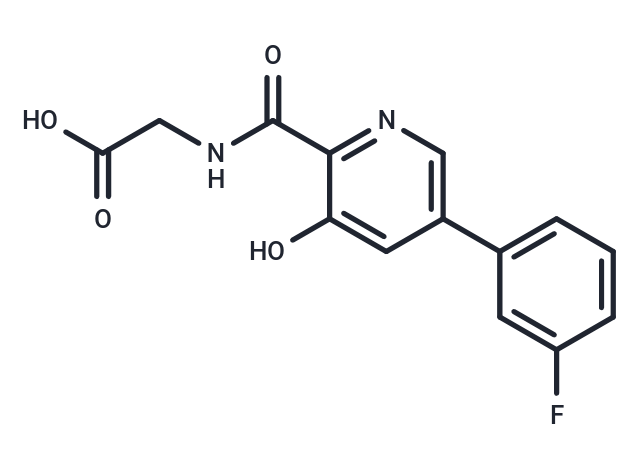Shopping Cart
Remove All Your shopping cart is currently empty
Your shopping cart is currently empty
AKB-6899 is an inhibitor of prolyl hydroxylase domain 3 (PHD3) and increases the soluble form of the VEGF receptor (sVEGFR-1) production from GM-CSF-treated macrophages. AKB-6899 leads to stabilization of HIF-2α which induces sVEGFR-1 production from tumor-associated macrophages and decreases tumor growth.

| Pack Size | Price | USA Warehouse | Global Warehouse | Quantity |
|---|---|---|---|---|
| 1 mg | $41 | In Stock | In Stock | |
| 5 mg | $103 | In Stock | In Stock | |
| 10 mg | $166 | In Stock | In Stock | |
| 25 mg | $287 | In Stock | In Stock | |
| 50 mg | $412 | In Stock | In Stock | |
| 1 mL x 10 mM (in DMSO) | $113 | In Stock | In Stock |
| Description | AKB-6899 is an inhibitor of prolyl hydroxylase domain 3 (PHD3) and increases the soluble form of the VEGF receptor (sVEGFR-1) production from GM-CSF-treated macrophages. AKB-6899 leads to stabilization of HIF-2α which induces sVEGFR-1 production from tumor-associated macrophages and decreases tumor growth. |
| In vitro | In murine bone marrow-derived macrophages, AKB-6899 (10 μM; 24 hours) increases the levels of HIF-2α protein, with no corresponding increase in HIF-1α. AKB-6899 shows no effect on HIF-1α accumulation or VEGF production[1]. |
| In vivo | In C57BL/6 mice injected with B16F10 murine melanoma cells, AKB-6899 (17.5 mg/kg; i.p.) significantly reduces tumor growth[1]. |
| Synonyms | AKB6899 |
| Molecular Weight | 290.25 |
| Formula | C14H11FN2O4 |
| Cas No. | 1007377-55-0 |
| Smiles | OC(=O)CNC(=O)c1ncc(cc1O)-c1cccc(F)c1 |
| Relative Density. | 1.436 g/cm3 (Predicted) |
| Storage | Powder: -20°C for 3 years | In solvent: -80°C for 1 year | Shipping with blue ice/Shipping at ambient temperature. | |||||||||||||||||||||||||||||||||||
| Solubility Information | DMSO: 95 mg/mL (327.3 mM), Sonication is recommended. | |||||||||||||||||||||||||||||||||||
| In Vivo Formulation | 10% DMSO+40% PEG300+5% Tween 80+45% Saline: 3.3 mg/mL (11.37 mM), Sonication is recommended. Please add the solvents sequentially, clarifying the solution as much as possible before adding the next one. Dissolve by heating and/or sonication if necessary. Working solution is recommended to be prepared and used immediately. The formulation provided above is for reference purposes only. In vivo formulations may vary and should be modified based on specific experimental conditions. | |||||||||||||||||||||||||||||||||||
Solution Preparation Table | ||||||||||||||||||||||||||||||||||||
DMSO
| ||||||||||||||||||||||||||||||||||||
| Size | Quantity | Unit Price | Amount | Operation |
|---|

Copyright © 2015-2026 TargetMol Chemicals Inc. All Rights Reserved.